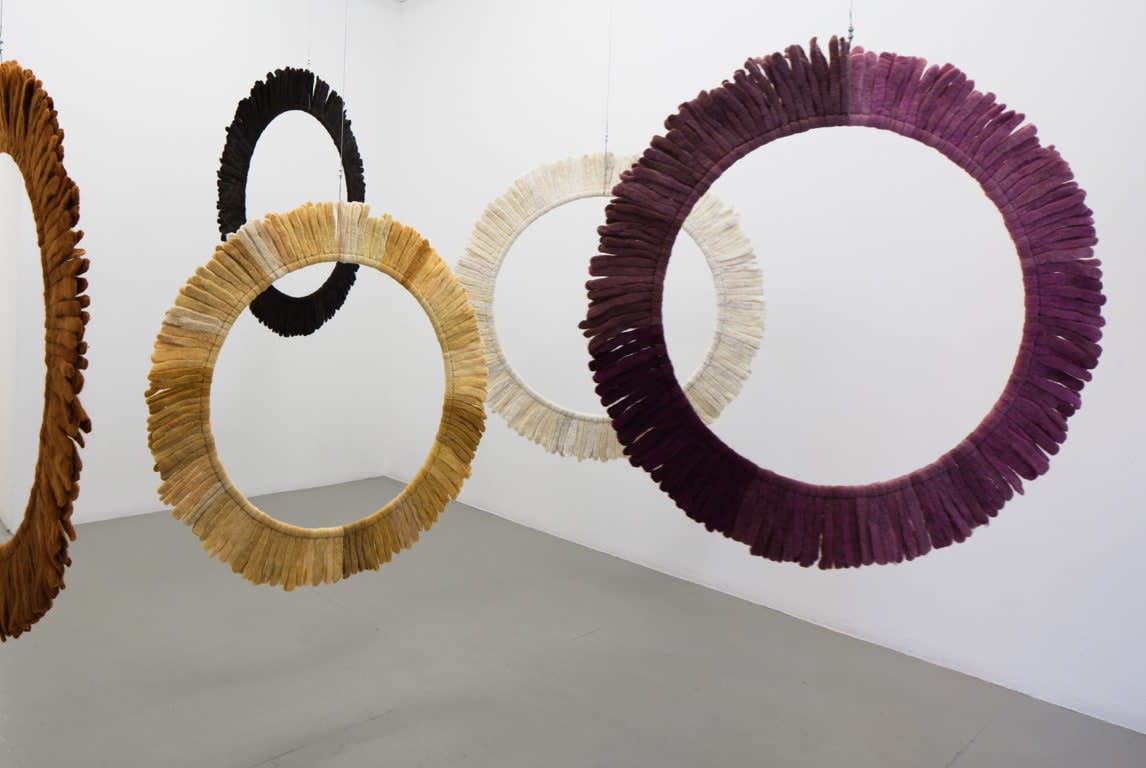Helén Svensson Swedish, b. 1964
Further images
The piece Do not touch the floor / Inte nudda golv consists of five wooden rings with wool strips hanging on wires at varying heights from the ceiling. Three of the rings are dyed with lichen: the yellow one with Slånlav Evernia prunastri, the brown one with Färglav Parmelia saxatilis, and the purple one with Tuschlav Lasallia pustulata. The white and black rings are the natural colour of the wool. Each ring has a diameter of 120 cm and consists of 120-134 needle-felted wool strips that are folded in half and sewn individually around the ring.
.
The creation of Inte nudda golv was a collaborative process with Ashik Zaman, aimed at crafting a hanging piece that would dominate the exhibition space and exude playfulness, contrasting with the controlled manufacturing process of the artwork.
This concept emerged from discussions about liberating the artwork from walls and floors, scaling up, and incorporating colour, as a way to expand the artist's increasingly reductive process. The title reflects the self-imposed rules the artist follows. The arrangement of the rings in relation to each other and the room allows viewers to experience the artwork from within and outside. As visitors move through the space, the rings begin to swing, creating subtle circular movements.
Work Process: The wool undergoes cleaning, washing, drying, carding, and formation into wool batts. The batts are felted by repeatedly poking a needle through them until the fibers interlock, forming rectangular sheets measuring 20 x 40 cm. These sheets are then cut into 10 long strips. This repetitive process continues until 670 strips are formed. Each strip is needle-felted along all cut edges.
Dyeing Process: The wool strips are alum-mordanted. Lichen is collected, ground into pigment, and used to dye the wool. Xanthoria parietina and Ochrolechia tartarea are boiled with the wool strips at different times to achieve various shades. Lecanora tartarea is processed separately with ammonia and water before being boiled with the strips. The dyed strips are then washed and dried.
The placement of the dyed wool strips on the rings is guided by an intuitive sense of the overall aesthetic, rather than specific dyeing times. The strips are folded in half, sewn around the ring, and further needle-felted to achieve a stretched appearance.
Wool is a fascinating material due to its diverse properties: it can be soft or itchy, enveloping or insulating, light or heavy, and has a distinctive smell. Working with wool allows for a methodical precision in all sub-processes. The meticulous care given to the seemingly simple form through the slow process of producing the wool strips imbues the material with value.
The lichens used were carefully harvested from trees, rocks, and stones, with only a small amount utilized for Inte nudda golv. The wool, sourced from various farms, was originally intended for disposal.







